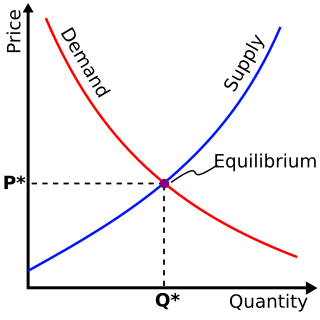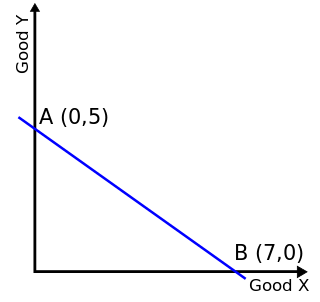Related Research Articles

Macroeconomics is a branch of economics that deals with the performance, structure, behavior, and decision-making of an economy as a whole. This includes national, regional, and global economies. Macroeconomists study topics such as output/GDP and national income, unemployment, price indices and inflation, consumption, saving, investment, energy, international trade, and international finance.

An economic bubble is a period when current asset prices greatly exceed their intrinsic valuation, being the valuation that the underlying long-term fundamentals justify. Bubbles can be caused by overly optimistic projections about the scale and sustainability of growth, and/or by the belief that intrinsic valuation is no longer relevant when making an investment. They have appeared in most asset classes, including equities, commodities, real estate, and even esoteric assets. Bubbles usually form as a result of either excess liquidity in markets, and/or changed investor psychology. Large multi-asset bubbles, are attributed to central banking liquidity.
An interest rate is the amount of interest due per period, as a proportion of the amount lent, deposited, or borrowed. The total interest on an amount lent or borrowed depends on the principal sum, the interest rate, the compounding frequency, and the length of time over which it is lent, deposited, or borrowed.
In behavioral economics, time preference is the current relative valuation placed on receiving a good or some cash at an earlier date compared with receiving it at a later date.

In economics, a budget constraint represents all the combinations of goods and services that a consumer may purchase given current prices within their given income. Consumer theory uses the concepts of a budget constraint and a preference map as tools to examine the parameters of consumer choices. Both concepts have a ready graphical representation in the two-good case. The consumer can only purchase as much as their income will allow, hence they are constrained by their budget. The equation of a budget constraint is where is the price of good X, and is the price of good Y, and m is income.

Fractional-reserve banking is the system of banking in all countries worldwide, under which banks that take deposits from the public keep only part of their deposit liabilities in liquid assets as a reserve, typically lending the remainder to borrowers. Bank reserves are held as cash in the bank or as balances in the bank's account at the central bank. Fractional-reserve banking differs from the hypothetical alternative model, full-reserve banking, in which banks would keep all depositor funds on hand as reserves.

In economics, crowding out is a phenomenon that occurs when increased government involvement in a sector of the market economy substantially affects the remainder of the market, either on the supply or demand side of the market.

Money creation, or money issuance, is the process by which the money supply of a country, or an economic or monetary region, is increased. In most modern economies, money is created by both central banks and commercial banks. Money issued by central banks is a liability, typically called reserve deposits, and is only available for use by central bank account holders, which are generally large commercial banks and foreign central banks. Central banks can increase the quantity of reserve deposits directly, by making loans to account holders, purchasing assets from account holders, or by recording an asset, such as a deferred asset, and directly increasing liabilities. However, the majority of the money supply used by the public for conducting transactions is created by the commercial banking system in the form of commercial bank deposits. Bank loans issued by commercial banks expand the quantity of bank deposits.

Household debt is the combined debt of all people in a household, including consumer debt and mortgage loans. A significant rise in the level of this debt coincides historically with many severe economic crises and was a cause of the U.S. and subsequent European economic crises of 2007–2012. Several economists have argued that lowering this debt is essential to economic recovery in the U.S. and selected Eurozone countries.

Real estate economics is the application of economic techniques to real estate markets. It aims to describe and predict economic patterns of supply and demand. The closely related field of housing economics is narrower in scope, concentrating on residential real estate markets, while the research on real estate trends focuses on the business and structural changes affecting the industry. Both draw on partial equilibrium analysis, urban economics, spatial economics, basic and extensive research, surveys, and finance.

Second mortgages, commonly referred to as junior liens, are loans secured by a property in addition to the primary mortgage. Depending on the time at which the second mortgage is originated, the loan can be structured as either a standalone second mortgage or piggyback second mortgage. Whilst a standalone second mortgage is opened subsequent to the primary loan, those with a piggyback loan structure are originated simultaneously with the primary mortgage. With regard to the method in which funds are withdrawn, second mortgages can be arranged as home equity loans or home equity lines of credit. Home equity loans are granted for the full amount at the time of loan origination in contrast to home equity lines of credit which permit the homeowner access to a predetermined amount which is repaid during the repayment period.
The paradox of thrift is a paradox of economics. The paradox states that an increase in autonomous saving leads to a decrease in aggregate demand and thus a decrease in gross output which will in turn lower total saving. The paradox is, narrowly speaking, that total saving may fall because of individuals' attempts to increase their saving, and, broadly speaking, that increase in saving may be harmful to an economy. The paradox of thrift is an example of the fallacy of composition, the idea that what is true of the parts must always be true of the whole. The narrow claim transparently contradicts the fallacy, and the broad one does so by implication, because while individual thrift is generally averred to be good for the individual, the paradox of thrift holds that collective thrift may be bad for the economy.

The permanent income hypothesis (PIH) is a model in the field of economics to explain the formation of consumption patterns. It suggests consumption patterns are formed from future expectations and consumption smoothing. The theory was developed by Milton Friedman and published in his A Theory of the Consumption Function, published in 1957 and subsequently formalized by Robert Hall in a rational expectations model. Originally applied to consumption and income, the process of future expectations is thought to influence other phenomena. In its simplest form, the hypothesis states changes in permanent income, rather than changes in temporary income, are what drive changes in consumption.
Credit rationing by definition is limiting the lenders of the supply of additional credit to borrowers who demand funds at a set quoted rate by the financial institution. It is an example of market failure, as the price mechanism fails to bring about equilibrium in the market. It should not be confused with cases where credit is simply "too expensive" for some borrowers, that is, situations where the interest rate is deemed too high. With credit rationing, the borrower would like to acquire the funds at the current rates, and the imperfection is the absence of supply from the financial institutions, despite willing borrowers. In other words, at the prevailing market interest rate, demand exceeds supply, but lenders are willing neither to lend enough additional funds to satisfy demand, nor to raise the interest rate they charge borrowers because they are already maximising profits, or are using a cautious approach to continuing to meet their capital reserve requirements.
The Fund Transfer Pricing (FTP) measures the contribution by each source of funding to the overall profitability in a financial institution. Funds that go toward lending products are charged to asset-generating businesses whereas funds generated by deposit and other funding products are credited to liability-generating businesses.
The financial accelerator in macroeconomics is the process by which adverse shocks to the economy may be amplified by worsening financial market conditions. More broadly, adverse conditions in the real economy and in financial markets propagate the financial and macroeconomic downturn.
Consumption smoothing is an economic concept for the practice of optimizing a person's standard of living through an appropriate balance between savings and consumption over time. An optimal consumption rate should be relatively similar at each stage of a person's life rather than fluctuate wildly. Luxurious consumption at an old age does not compensate for an impoverished existence at other stages in one's life.
A borrowing limit is the amount of money that individuals could borrow from other individuals, firms, banks or governments. There are many types of borrowing limits, and a natural borrowing limit is one specific type of borrowing limit among those. When individuals are said to face the natural borrowing limit, it implies they are allowed to borrow up to the sum of all their future incomes. A natural debt limit and a natural borrowing constraint are other ways to refer to the natural borrowing limit.
The monetary transmission mechanism is the process by which asset prices and general economic conditions are affected as a result of monetary policy decisions. Such decisions are intended to influence the aggregate demand, interest rates, and amounts of money and credit to affect overall economic performance. The traditional monetary transmission mechanism occurs through interest rate channels, which affect interest rates, costs of borrowing, levels of physical investment, and aggregate demand. Additionally, frictions in the credit markets, known as the credit view, can affect aggregate demand. In short, the monetary transmission mechanism can be defined as the link between monetary policy and aggregate demand.

This glossary of economics is a list of definitions of terms and concepts used in economics, its sub-disciplines, and related fields.
References
- ↑ Williamson, Stephen D. (2018). "Liquidity Constraints". The New Palgrave Dictionary of Economics. Palgrave Macmillan UK. pp. 7912–7919. doi:10.1057/978-1-349-95189-5_2438. ISBN 978-1-349-95188-8 . Retrieved 26 May 2021.
{{cite book}}:|website=ignored (help) - ↑ Wilcox, James A. (Fall 1989). "Liquidity Constraints on Consumption: The Real Effects of "Real" Lending Policies" (PDF). Economic Review (4). Federal Reserve Bank of San Francisco: 39. Retrieved 26 May 2021.
- ↑ Hubbard, R. Glenn; Judd, Kenneth L. (1986). "Liquidity Constraints, Fiscal Policy, and Consumption" (PDF). Brookings Papers on Economic Activity (1): 1–59. doi:10.2307/2534413. JSTOR 2534413 . Retrieved 26 May 2021.